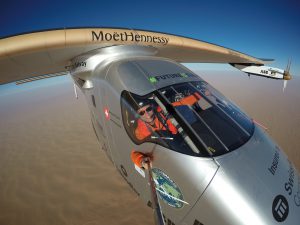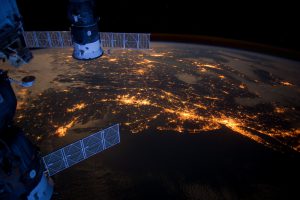At around 4am Gulf Standard Time and after 48 hours of continuous flight, the Solar Impulse 2, the first plane to complete a solar-powered flight around the globe, landed at Abu Dhabi airport. As it did so, our perceptions of the limits of renewable energy power shifted.
The aircraft took off from New York in March last year, with the ambition of becoming the first zero fuel plane to circumnavigate the world, a feat that took 16 months to achieve. The single-seater plane, with the wingspan of a Boeing 747, was not built to transport passengers but to carry a message about the use of clean technology.
Bertrand Piccard and Andre Borschberg, the Swiss founders of the project, took it in turns to pilot the plane over the 40,000 kilometre flight (broken down into 17 legs), during which not a single drop of fuel was used.
The epic journey was not with its difficulties. Early last year, there were weeks of delays caused by crosswinds in China, and overheating batteries during the Pacific stretch forced it to spend the winter inside a Hawaiian hangar.
GoPro footage from the last leg of the Solar Impulse 2’s round-the-world voyage. Credit: https://www.solarimpulse.com
Upon touchdown, founder Bertrand Piccard, a psychiatrist and balloonist, reflected on the meaning of the voyage.
“I hope people will understand that it is not just a first in the history of aviation, but also a first in the history of energy,” he said, adding. “I’m sure that within the next 10 years we’ll see electric [aircraft] carrying 50 passengers on short- to medium-haul flights.”
Now that the Impulse has landed, and the dream of emission-free aviation has been realised, people are asking when exactly will the first commercially chartered flight take off, and which country will supply the technology? But intense speculation has obscured the more immediate benefits bestowed by the voyage, such as the application of solar technology in homes, offices and factories.
“All the clean technologies we use [in the craft], they can be used everywhere…These technologies now can make the world much better and we have to use them, not only for the environment, but also because they are profitable and create jobs,” said Piccard in an interview with the Guardian.
The plane’s lightweight materials and other components can be used to build roads, for example, by providing new types of ground insulation used in highways and other lightweight construction. The energy efficiencies needed to power the plane’s 24-hour electrical engine can be deployed in car manufacturing. While the energy-dense lithium polymer batteries that enabled the plane to fly at night will change the way we store power.
Dan Rutherford, program director for marine and aviation technology at the International Council on Clean Transportation, said that one of the biggest lessons is about using electricity instead of combustion and hydraulics to power machinery.
“We’ve already seen a movement toward more-electric aircraft,” Rutherford says, pointing to the Boeing Dreamliner, which despite some major teething problems, uses batteries to power its computers. Between the pioneering advancements boasted on the Solar Impulse and the most advanced commercial planes going into service today, “definitely you are seeing an overlap,” he said in an interview with National Geographic.
SunPower, a company which provided the Impulse’s solar cells, has advanced the field of durable solar appliances over the last eight years working on the project. Their work on the Honda Dream, a solar racecar, and the NASA rover that explored Greenland’s icecap, is also being deployed in residential and commercial projects.
Piccard hopes it will lay the foundations for a world council for clean technologies that will “allow experts and specialists to advise governments and big corporations on which types of technology to use to profitably fight climate change and profitably protect the environment.”
The founders have already launched a Future Clean initiative, designed with Google, aimed to highlight the potential for clean technologies ahead of last year’s UN climate summit in Paris.
That said, the Solar Impulse is unlikely to provide a solution to decarbonising the aviation industry.
While solar energy may be able to help a small aircraft fly, it is unlikely to be a practical solution for propelling larger, much heavier commercial airliners into the sky – even with the most energy efficient panels. Even so, the issue of aviation emissions can no longer be ignored. By some estimates, a single person round-trip flight from New York to London generates approximately the same greenhouse gas emissions as heating a residential home for a year. Alternative power solutions will need to be found if the world is to succeed in its goal of reducing global warming.
Notable zero-emission forms of transport…
Solar Voyager
A small, autonomous solar-powered boat that is attempting to cross the Atlantic Ocean to demonstrate the power of green energy. The craft left Boston harbour on June 1 and is expected to make landfall in Portugal in October
Europe’s first zero-emission train station
A geothermal train station, thought to be Europe’s first carbon-neutral train station, opened in June 2014 by German railway company Deutsche Bahn
e-Genius
Built by engineers at the University of Stuttgart, an all-electric airplane that crossed a 62-mile stretch for a total energy cost of just over US$3, according to its pilot, Klaus Ohlmann
The IPEMU
The first battery-powered train to run on the UK’s rail network in more than half a century. Network Rail said it will contribute to the company’s goal of reducing its environmental impact, improving sustainability and reducing the cost of running the railway by 20% over the next five years









